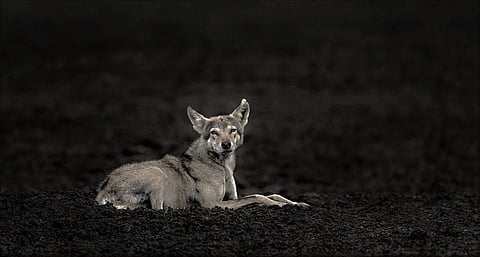

Lions, tigers and bears, oh my! Much like the infamous song from the movie The Wizard of Oz, these are also some of the common animals we hear about in school when learning about India's wildlife. But wildlife conservationist Shruti Suresh avers that wildlife in India is more diverse than that and consists of some beautiful, unique and rare species. This is also why Shruti is an advocate for conservation of the grasslands in North Karnataka that is home to many animals especially wolves. It's been more than one year since Shruti has been writing comprehensively about the details of these species found only in Koppal.
The story behind her interest in wildlife found in grasslands and shrublands is an interesting one. After completing her Communication Studies from Mount Carmel College in Bengaluru, Shruti pursued an MSc in Conservation and Biodiversity from the University of Exeter. Unlike other students, she volunteered with CUPA during her graduation and that's where she developed an interest for wildlife. She says, "The interest to conserve and work for wildlife developed over a period of time. I wanted to get into conservation as it can help solve ecological problems on a larger scale and affect policy formation. I applied for the World Wide Fund for Nature's Youth Volunteership Programme. I travelled to Cambodia and worked as a communications intern. But I was always sure that I would return to India and work for my country. Though our country comes with a whole set of problems, it is rich in its culture and biodiversity and being in the tropical belt is one of the many advantages we have."
When she returned to India, Shruti wanted to work with the Deccan Conservation Foundation based in Koppal. Their projects aim to conserve and manage endangered and threatened fauna including the Indian Grey Wolf and associated species in Koppal. But in 2019, when Shruti applied to work with them, they were not in the process of hiring anybody. So, she joined the Centre for Wildlife Studies instead, who gave her a platform to conduct her research on wolves.
"The Indian Grey Wolf is particularly charismatic; they are listed under Schedule-I of the Wildlife Protection Act 1972. If you are working to protect any animal, you must work to protect these three factors - food, shelter, water - to allow the species to propagate. This leads one to inevitably protect their habitat. In this process, we end up saving more than one species," she says and adds, "According to my research on the field, the grasslands found in Koppal are India's oldest grasslands in the Deccan Plateau. However, a lot of changes have happened due to modernisation, like converting grasslands into agricultural land, industry, mining and so on, which is destroying the few spaces left for animals. Koppal, in particular, has sloth bears, leopards, striped hyenas, jackals and foxes. Grasslands are a part of wildlife conservation but we are taught to protect only forests and areas with huge tree cover and water resources. Earlier, these grasslands were home to black bucks. The Chinkara has also gone extinct and you will find only a few wild boars here and there. These animals were the main source of food for animals like wolves and leopards."
Shruti feels sad for this loss due to which wolves and leopards now largely depend on the sheep reared by farmers and crops like watermelon. "Here is why I say wildlife and human relations go hand-in-hand. People need to protect their property and crops, hence it becomes essential to form policies that benefit different stakeholders including the forest department, the government and individuals. We must make such places attractions for tourists, that's when the demand to save grasslands will increase. This will also improve the socio-economic status of the people living here, " says Shruti, adding, "As an individual, if you have the resources, then provide funds to these organisations working for the protection of wildlife. Volunteer your time, if you can. Question the policies of the government and create awareness among people. In the past five years, we have lost 31 per cent of grasslands due to conversion. The latest policy, EIA 2020, needs many voices to be raised. It is not just about protecting our environment, it is about protecting our rights in a democracy. Help schools and our textbooks broaden their spectrum of wildlife."
